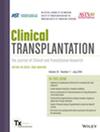Intraoperative Hemodynamic Monitoring and Prediction of Early Allograft Dysfunction Following Living Donor Liver Transplantation: A Systematic Review
Abstract
Background
Multiple intraoperative hemodynamic parameters are associated with an increased risk of early allograft dysfunction (EAD) following living donor liver transplantation (LDLT); however, there is significant center-to-center variability in terms of which parameters are used. We sought to determine which intraoperative hemodynamic parameters are most predictive of EAD following LDLT.
Methods
This is a systematic review following PRISMA guidelines (PROSPERO ID: CRD42023409711). Receiver operating characteristic (ROC) analyses were used to compare predictive parameters.
Results
A total of 4399 articles were identified from 3 large, international databases (PubMed, Embase, and Web of Science). Eighteen articles fit the inclusion criteria. The most commonly evaluated hemodynamic parameter was the postreperfusion portal venous pressure (PVP). A postreperfusion PVP of <15–20 mmHg was consistently associated with lower rates of EAD and, in some cases, improvements in patient survival. Other hemodynamic parameters evaluated included portal venous flow, hepatic arterial flow, portal venous velocities, and the hyperperfusion index.
Conclusion
Hemodynamic measurements indicative of portal hyperperfusion, especially elevated PVP, have been consistently associated with the development of EAD. Intraoperative hemodynamics should be monitored on all LDLT recipients, with portal inflow modulation procedures indicated if portal hyperperfusion is present.


 求助内容:
求助内容: 应助结果提醒方式:
应助结果提醒方式:


